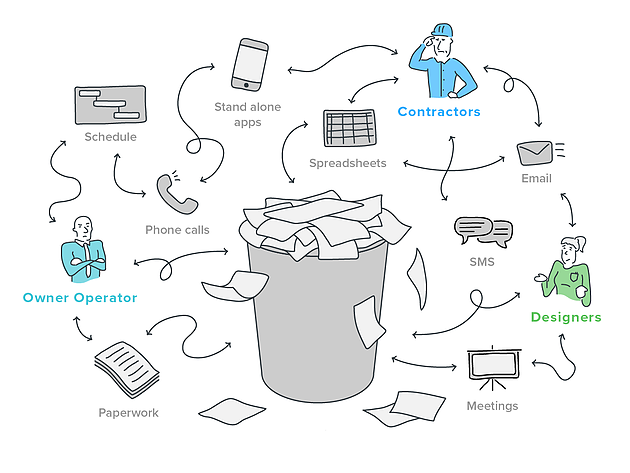Navigating Intricacy: How Construction Document Management Software Can Assist
Navigating Intricacy: How Construction Document Management Software Can Assist
Blog Article
Achieving Seamless Project Shipment: Designer's Comprehensive Approach to Construction Document Administration
One essential aspect frequently took too lightly is the monitoring of building documents, which serves as the backbone of every project. As engineers browse the intricacies of style, execution, and coordination, a detailed method to record monitoring emerges as a linchpin for attaining smooth project shipment.
Significance of Building File Administration
Reliable building paper administration plays an essential duty in making certain project success by assisting in smooth interaction and organization throughout the building and construction procedure. By preserving accurate and up-to-date construction documents, designers can efficiently connect with specialists, subcontractors, and various other stakeholders involved in the project. These documents offer as a referral point for all events, ensuring that every person is working from the exact same collection of info and lowering the chance of mistakes or misunderstandings.
Furthermore, proper record monitoring can boost task performance, lower costly delays, and ultimately lead to the successful conclusion of construction projects. Designers who focus on building paper administration set a solid foundation for task success and show a dedication to supplying top quality results.
Trick Aspects for Effective Documentation

Offered the essential duty that accurate and well organized building and construction documentation plays in making sure task success, it is vital to identify essential aspects that contribute to reliable documentation monitoring. First of all, clear and concise communication is paramount. All stakeholders must recognize the paperwork needs and have the ability to access and translate the info conveniently. Developing standardized design templates and protocols makes sure uniformity throughout all job papers. This includes naming conventions, file structures, and modification control to stop errors and confusion. Normal testimonials and updates are important to maintain documentation reflective and current of the task's progression. This practice assists determine any type of discrepancies or changes that require to be attended to immediately. Applying a robust file management system that enables for version control, accessibility restrictions, and audit routes considerably enhances the organization and safety of task documents. By including these crucial elements into construction paper management practices, designers can simplify procedures, minimize mistakes, and inevitably add to the effective delivery of tasks.
Using Technology for File Organization
Leveraging sophisticated digital tools and software application systems contributes in boosting the company and accessibility of building and construction documentation. Building firms can improve their file administration processes by applying specialized software application designed for the building market. These devices offer functions such as variation control, cloud storage, and collective modifying capabilities, allowing staff member to work on documents all at once and making certain everybody has accessibility to the most up-to-date information.
One trick advantage of using technology for document organization is the capacity to produce a centralized repository for all project-related documents. By keeping papers in a safe digital environment, architects can conveniently browse, get, and share info with stakeholders, decreasing the risk of variation disputes or misplaced documents. Furthermore, progressed software application services frequently incorporate metadata tagging and indexing capabilities, enabling users to classify documents successfully and obtain them quickly when required.
Collaborative Strategies With Job Teams
To enhance project results, engineers need to embrace collective approaches when collaborating with project groups to ensure seamless interaction and coordination throughout the building and construction process. Partnership with task teams is crucial for architects to successfully manage building tasks. construction document management. By fostering open communication and synergy among all stakeholders, designers can streamline decision-making processes, address prospective concerns proactively, and guarantee that everybody is straightened with the project objectives
Designers must establish clear lines of communication with engineers, professionals, clients, Look At This and various other vital group participants from the beginning of the job. Routine meetings, progression updates, and responses sessions should be set up to maintain everybody informed and involved. Making use of collective task monitoring devices can additionally help with real-time details sharing and record cooperation, boosting openness and effectiveness.

Finest Practices for File Version Control

Verdict
Finally, my sources effective building and construction file management is critical for accomplishing smooth job distribution. By concentrating on key components such as collaboration, company, and version control, architects can make sure that all project groups are functioning from accurate and updated information. Utilizing modern technology view can improve the documents procedure and boost general task efficiency. It is important for designers to implement best practices in file monitoring to successfully navigate the complexities of building and construction projects.
Efficient building and construction file management plays a critical function in guaranteeing project success by promoting seamless communication and organization throughout the building process. Furthermore, proper record administration can improve job performance, reduce costly hold-ups, and inevitably lead to the effective conclusion of building tasks.To maximize job end results, architects need to accept collective approaches when working with task groups to make sure seamless communication and coordination throughout the construction procedure. Partnership with job teams is vital for designers to efficiently manage building and construction tasks.In the realm of joint building and construction job administration, maintaining specific control over paper versions stands as a crucial technique for guaranteeing project integrity and communication.
Report this page